

Necropolis
This necropolis lies in a depression between the city of Orvieto and the hills to the south east of it, which linked the port of Pagliano on the Tiber to the sanctuary at Campo della Fiera. It seems to have been named for the cane (canna) that still grows nearby. The area is subject to subsidence, so that the tombs here are not well-preserved. Yet more damage was done in the early excavations that began in the 1870s. None of the grave goods from these early excavations remain in Orvieto, and those that have been dispersed have little to indicate their precise provenance.
Systematic excavations in four different areas of the necropolis began in the 1970s. Those carried out in the early 1990s near the temple (see below) revealed some particularly interesting finds:
-
✴A tomb (6th century BC) has an interesting Etruscan inscription: "[m]i aviles katacinas" (I am [the tomb of] Aviles Katacinas). The deceased had an Etruscan-Latin first name (Aule, Aulus) and a family name that is probably of Celtic origin. The inscription is also discussed in context in the page Early Etruscan Inscriptions.
-
✴Another, much later tomb (early 2nd century BC) belonged to a woman, who still gazed into a mirror propped upright before her that was engraved with a figure of a Lasa (a female guardian of graves).
It seems that this necropolis pre-dated that of the Crocifisso del Tufo. The tombs are of similar construction and are similarly laid out on an orthogonal plan, with the difference that those here were laid out on terraces. Shortage of space probably led to the practice of re-using earlier burial sites.
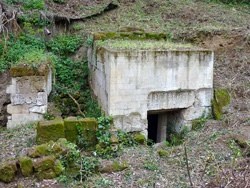
One of the few exposed tombs from the necropolis can be seen on the left of the lane that is signed to B&B Cannicella.
[Since my last visit, the necropolis has become more accessible to visitors, as reported here in ‘Orvietonews’.
Temple
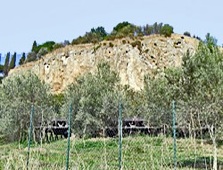
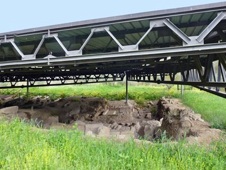
Another distinguishing feature of the Cannicella necropolis is the presence of a temple (6th century BC) at its centre, which Riccardo Mancini discovered in 1884. The sanctuary, which seems to have been dedicated to Vei (see below), the goddess of death and fertility, was excavated in 1900 and 1936 and then from 1971.
The site of this temple, which is a few meters below the lane to B&B Cannicella, is now covered and enclosed by a fence. The temple was built on the third terrace of the necropolis, and was supported by a retaining wall. It was enlarged in the 4th century BC, partly at the expense of the earlier tombs nearby. Underneath, excavation discovered a well and a series of basins and conduits that fed them with water.
Finds in the Museo Civico
The following are in the Museo Civico:
Inscription

This inscription “thval veal” reveals that the temple was dedicated to Vei (Demeter). It is also discussed in context in the page Early Etruscan Inscriptions.
“Venus” of Cannicella
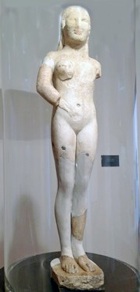
Funerary cippus (late 6th century BC)
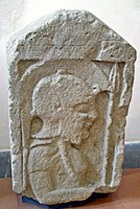
Terracotta Decoration

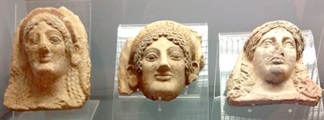
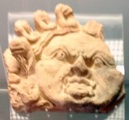
The following exhibits also came from the site of the temple:
-
✴the lovely terracotta head of a woman;
-
✴a series of terracotta antefixes representing one or more goddesses; and
-
✴a terracotta antefix representing a gorgon.
Finds in the Museo Archeologico Nazionale
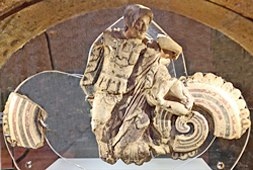
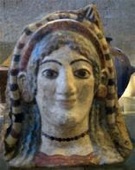
These finds (7th-5th centuries BC) from the temple are in the Museo Archeologico Nazionale:
-
✴a fragment of a painted terracotta relief of a soldier slaying a woman (ca. 500 BC) that represents Neoptolemus, the son of Achilles sacrificing Polyxena, Princess of Troy to placate his father’s ghost; and
-
✴a beautifully preserved antefix in the form of a polychrome female head with particularly arresting features that possibly represents the goddess Vei.
Read more:
P. Bruschetti, “Le Necropoli di Orvieto”, in:
G. della Fina and E. Pellegrini (Eds), “Da Orvieto a Bolsena: un Percorso tra Etruschi e Romani”, (2013) Pisa, pp. 60-75
A. Feruglio, “Le Necropoli Etrusche”, in
G. della Fina and E. Pellegrini (ed), “Storia di Orvieto: Antichità”, (20o3) Perugia, pp 275-328
S. Stopponi, “Itinerari Etruschi: Orvieto” (1985) Milan
A. Andren, “Il Santuario della Necropoli di Cannicella ad Orvieto”, (1968) Orvieto
Return to Museums and Excavation Sites in Orvieto.
Return to: Walk I (if you are doing the detour from Palazzo Crispo Marsciano); or
Walk IV (if you are returning to the city from SS Severo e Martirio).

